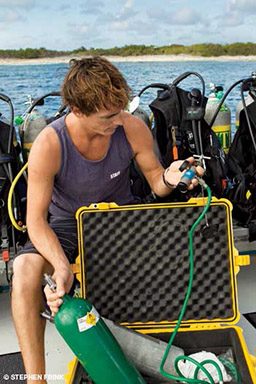I never earned my dive instructor certification because I’ve only ever wanted to teach photography, not scuba. I am, however, a Professional Association of Diving Instructors (PADI) limited field specialty instructor. To be that, I needed to be a divemaster, which meant I had get my rescue certification. Rescue was a class I very much wanted to do anyway, even though I had taken it unofficially many, many years ago and have actually rescued several divers in my 45 years of diving.
The Event
I had a student who wanted to take an underwater photo class with me on my private photo boat, and she brought her son along. The son was a certified diver, but I knew that neither I nor his mother would be able to pay much attention to him while we were engaged in the photography class. So I assigned a dive instructor from my staff to be his buddy.

Toward the end of our dive I looked down and saw the son was deeper than we were. Since we were close to our time limit, I became concerned about the possibility he and the instructor were too deep and had been down too long. I got the instructor’s attention and vehemently indicated that he should get the son back to the line for ascent.
I turned to my student and started toward the mooring line. I looked back just in time to watch her son do a rapid, uncontrolled ascent to the surface — he had forgotten to control his BC. I could not reach him, and the instructor wasn’t able to get close enough to grab his fin. I saw the son slow his ascent, and I motioned for him to come down to us immediately. I wrote on my slate to the mother that we were going to have a problem. I told her to stay on the line with her son until I signaled for them to come up. The son joined us and signaled that he was OK, but I wanted to be ready.
I went up to the boat and set up my DAN® oxygen unit, but I had never used it before. I always have an instructor on board when I have students on my boat, and I have complacently depended on them to know how to use it. I was not at all happy with myself, and I lamented putting off taking an oxygen-provider class. Fortunately, the unit was already set up and just waiting to be turned on.
I brought up the instructor and then the mother and the son, and I had the instructor put the son on oxygen. It seemed simple enough, but I could not personally check that it was being done properly. I was lucky the son was able to breathe OK and had no symptoms, and I was lucky I was with another person who knew how to deliver the oxygen. As long as the young man was comfortable, we were OK. We cancelled the second dive and headed for the dock. The diver was feeling all right and got up momentarily to move, so he went off oxygen briefly. That’s when the symptoms started. He went back on oxygen until an ambulance could meet us at the dock. He was taken to the hospital, and after two Table 6 chamber treatments, he was fine.
The Lessons
I am happy I was experienced enough to understand the potential ramifications of this incident and confident enough to initiate emergency procedures even before any symptoms appeared. I was lucky the young diver could breathe on his own, and I was stupid not ever to have taken a course in oxygen delivery. It is foolish to depend on someone else for this. What if the instructor forgot everything or had been the injured diver? Or what if this had been my friend who dives with me five weeks a year without any instructors on board? And even after all these realizations, several weeks later I still had not taken an oxygen-delivery course. I was always busy — and dumb.
The Solution
DAN came to the rescue. DAN staff came to Cayman and conducted a presentation about dive safety. I have been a member of DAN for ages, and I attended an excellent talk by Dan Orr. I was ecstatic when I was offered the opportunity to take an oxygen course right in my own photo center with all my instructors. During the course I was amazed at how much I did not know and how important it is to practice using the system. I will repeat that: You must practice using the system. As I write this, I am mentally reviewing what we learned, and I realize I’ve already started to forget some of the specifics from many months ago. But I now know exactly what to do: I had better get my classmates from the oxygen course together again for a quick refresher.
Can all of you who spend time in dive settings operate an oxygen-delivery system correctly? Everyone should be able to, since you never know when the trained person will be the victim. Don’t depend on others to take care of you and your buddy — sign up for a class; it’s simple. Like most things, administering oxygen is easy once someone shows you how. Had my student’s son not been placed on oxygen so quickly, I hate to think how that incident might have turned out.
© Alert Diver — Q1 Winter 2013